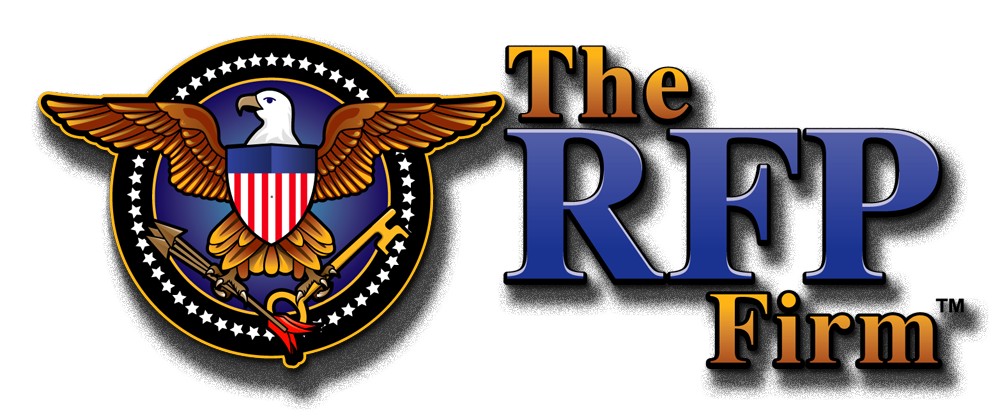Blog
Government & Commercial Proposal Writing Services
 The RFP Firm is expert at writing proposals in Response to Federal and State Government RFP Solicitations that will give you a Competitive Advantage over your competition.
The RFP Firm is expert at writing proposals in Response to Federal and State Government RFP Solicitations that will give you a Competitive Advantage over your competition.


Proposal Writing Services , RFP Proposal Consulting, Government RFP writing
Government RFP Proposal Writing Services
Government & Commercial Proposal Writing Services
 The RFP Firm is expert at writing proposals in Response to Federal and State Government RFP Solicitations that will give you a Competitive Advantage over your competition.
The RFP Firm is expert at writing proposals in Response to Federal and State Government RFP Solicitations that will give you a Competitive Advantage over your competition.

Why does the Government issue a Request for Proposal?
What actually is a Request for Proposal or RFP? Why do Governments issue RFPs?
Governments issue RFPs when they have a need for a contractor or vendor to supply specific products or services and now have the budget approved to finance it. The documents provide details of the scope of work and an outline of the project requirements or tasks. By issuing a public solicitation, they provide opportunities for companies to compete for the contract and then compare them in order to select the best fit based on their evaluation criteria.
This is especially significant when a new or complex project is being proposed that will need to be outsourced. When they are unsure of the specific steps and technologies that the project may entail, they often initially issue a Request for Information (RFI) to get input from prospective contractors. The information received is then used in preparation of a full Request for Proposal that will result in an actual contract with the selected vendor.
During the evaluation process, they are able to compare the bidders and uncover their strengths and weaknesses, assigning points to various criteria and awarding the contract to that vendor with the highest score, thereby justifying their choice. Also, understanding each vendor’s strategy enables them to compare alternatives prior to making the commitment to a specific vendor.
Request for Proposal (RFP) vs Request for Quote (RFQ)
In comparison, an RFQ, Request for Quote has its main focus on the price quoted by competing vendors. Often the vendors have already been vetted or were targeted by the agency based on prior experience or knowledge and feel that the lowest price will bring them the best value overall. The RFP on the other hand will include a technical approach, action plan, management plan, timeline and schedule, and more.
When it’s important to ensure that the company has an effective approach, the past experience with the scope of work, and the staff capable of accomplishing the tasks, that is when a full Request for Proposal is required.
With an RFQ, the agency will only receive a quote for the product or service that they are interested in purchasing without all of the detailed plans included in a full RFP.
RFP Process
In order for prospective vendors to prepare a proposal, the government agency will issue an RFP that describes what it is that they are looking for, the experience that vendors have providing similar services, the qualifications of the company and staff, the various certifications required, and the cost of providing those services. It also describes the required format that they must use when preparing the final proposal content. Sometimes they ask for everything to be provided in one document, but more often they request multiple volumes with the core sections divided into separate tabs within each volume.
During the proposal period, vendors are able to submit questions to clarify information within the RFP documents or to correct obvious misstatements or to help them determine how to price the contract. As a result, the agency will issue an addendum answering those questions and/or correcting errors in the RFP.
Evaluation of Submitted Proposals
During the evaluation process an attempt is made to measure the quality of the responses in comparison one to another and assign points for each major section. Sometimes an initial review is done, and the top bidders are then reviewed more closely with a final contractor being awarded. Those final bidders can even be requested to make their “best and final offer.”
The government RFP process is designed to ensure competitive bidding between interested vendors. This also saves the government time and effort from having to go out and identify prospective contractors, vet them, and hopefully select the best available company.
By issuing an RFP, the agency can focus on what they need, create an outline of those needs and requirements, and distribute it publicly allowing those interested vendors to send them a focused proposal designed to address their specific needs. It then enables them to compare different strategies and levels of experience.
As a vendor, you want to make sure that your proposal stands out from the rest by differentiating your approach from the competition and describing why that approach will provide the government agency with the best results. This is the goal of The RFP Firm when preparing your proposal.
What the Government Looks For in a Winning Proposal
The Government wants to select the vendor with the highest probability of success within a reasonable cost. So, risk mitigation is key. When describing how you do what you do, you must address why you do it that way and provide proofs that it is the best approach or examples of successful similar implementations done in the past. Identify unforeseen obstacles and how you were able to successfully overcome them. What were your lessons learned that have improved outcomes going forward. What were the benefits: cost, time, resources, etc. Additionally, be sure to include:
At The RFP Firm, once we understand the government agency’s most critical issues, we emphasize your company’s ability to manage those issues and identify how you will do so.